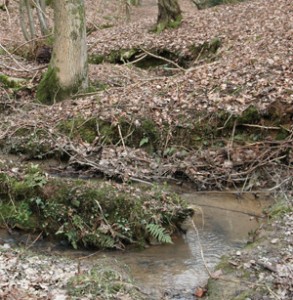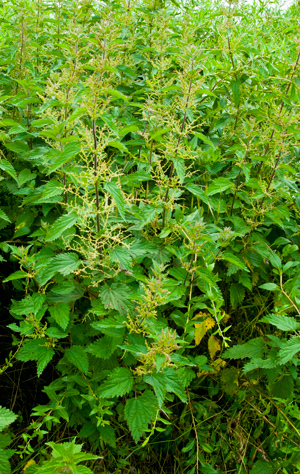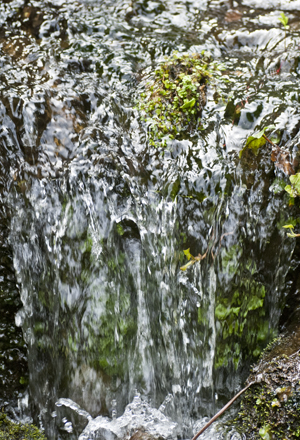Nitrates, land use and fresh water systems.

Nitrogen is an important plant nutrient. Generally, it is taken up in the form of nitrate (NO3) and it is used in the formation of amino acids, proteins and the constituents of the genetic material (DNA). Some plants fix atmospheric nitrogen through the use of symbiotic bacteria in root nodules. However, modern / intensive farming involves the addition of nitrogen compounds in the form of manure, sewage sludge and chemical fertilisers.
Couple this with the aerial deposition of nitrogen compounds, estimated at 400,000 tonnes / yr from car exhausts etc. (in the form of ammonia, nitrogen oxides) to give the total burden of nitrogen pollution. Pollution from such widespread sources is referred to as diffuse contamination.
The build-up of soluble forms of nitrogen, particularly nitrate, in water is a concern since high concentrations in rivers, streams and lakes promotes eutrophication, and high concentrations in drinking water are a concern for health reasons. The diffuse contamination of woodlands and roadsides is thought by some to encourage ‘nitrophiles’ or nitrophytes – plants, like nettles, that can use and exploit a nitrate-rich environment to the virtual exclusion of others.
that can use and exploit a nitrate-rich environment to the virtual exclusion of others.
Changes in agricultural practice since WW2 have particularly affected nitrate levels. Two changes, in particular, have impacted on water and nitrate levels:
- Significant areas of grassland were ‘ploughed in’ and this led to the oxidation of nitrogen compounds in organic matter in the soil to nitrites and nitrates
- The application of artificial nitrogenous fertilisers (rich in nitrate / ammonium compounds)
These changes increased the amount of nitrate leaching from the soil as rain percolated and eventually a gradual, but marked, increase in the concentration in ground water became evident in the early 1970s.
Now, a team of university academics (from Bristol, Cranfield and Durham) has tracked down and analysed records of water quality for the River Thames that extend back to 1868. Some of the records were found in the National Archives, others at Stamford University, California (!) - they held information on levels of nitrate, ammonia, chlorine, water hardness, dissolved oxygen and organic carbon. Some six different data sets was cross referenced / calibrated. The sampling of the Thames began back in the C19th century because of concerns about outbreaks of cholera, and the stench that often emanated from the river as it passed through London. Indeed, parliamentary sessions were suspended in 1858 because of the appalling smell that came from the river.
These records show an inexorable climb in the level of nitrate, and though there has been a general improvement in quality of the water (levels of oxygen and organic matter) so that fish have returned to the Thames – the increasing levels of nitrate will not have been without effect. (Nitrate and phosphate pollution have been responsible for eutrophication in various freshwater ecosystems – such as the Norfolk Broads).
The level of nitrate in the Thames has increased threefold since the 1930’s. The data indicate that changes in land use (surrounding the Thames) in the C20th affected nitrate levels – specifically the ‘Dig for Victory’ policy, which lead to many grasslands being used for arable crop production. Then later changes in agricultural practice of the 1960’s and 70’s saw the greater use of agrichemicals / fertilisers. Surface run-off of nitrate was one immediate effect, but there was also a longer-term permeation of nitrate into aquifers – and its later release into streams and rivers. Nitrate moving in this pathway can take three decades. The nitrate levels of the Thames are high due to this deferred release of materials / chemicals used in decades past.
Nitrate vulnerable zones (NVZs) were introduced in the 1990s – with the idea of limiting the discharge of N compounds to freshwater systems, through the control of the application of manure and N-based fertilisers to farming land etc. However, assessment of their effectiveness will presumably be difficult due to the large quantities of ‘historical nitrate’ held in rocks and aquifers – in areas like the Thames basin..
Comments are closed for this post.
Discussion
From this article we should not expect to see the first results, positive, or otherwise, from the NVZ’s until at least 2020. The results of today, will not be seen until 2040 at the earliest. Just a pity that any form of adjustment depends on these results, and therefore, that the benefit of such measures will only be felt 20 -30 years thereafter. This means that progress is expected to be extremely slow.
Obviously, we can move from spark ignition, to compression ignition, by an act of parliament if necessary, within 5 years, simply by the immediate ban on the production of spark ignition hardware. Such a measure would conserve vast measures of crude oil. This could be further improved by the improvement of Mass (Public) Transport, as also by the advent of large road trains for goods transport. The entire rail transport should be re-nationalised, which would remove large volumes/weights of goods transport from the road network, and would easilly improve the efficiency of both goods, as also passenger transport.
The advantage of scale in transport operations should not be overlooked.
A 5cwt (net) van/pickup/car moves 250Kg of freight, * or 1.6 passengers * ca. 50 miles/gallon of diesel. This equates to 12.5 tonne-miles/gallon, or 80 passenger miles/gallon.
A 60t (gross) truck moves 45t (net) 8 miles/gallon, an efficiency of 360t-miles/gallon. This is at least 30 fold as efficient as the 5cwt example. We do not need perfect accuracy in such a case, the mathematic results are so loud.
A 72 seat bus, with only 30 passengers, also runs at 8 miles/gallon. this equates to at least 240 passenger miles/gallon, this is at least 3 fold the example of the private car, which we need to multiply by at least 18 cars, @50 MPG each, a total fuel expence of 18 gallons for the identical journey. This is obviously twice the fuel expence of the bus, wich could theoretically, at least double it’s performance as it now stands, devoid of any further fuel consumption/expence/congestion/pollution.
The congestion caused by private cars also adds to the fuel consumption/expence/polution of all road transport, both goods, as also passenger.
All air pollution soon becomes ground/soil, and therefore water polution.
* The passenger figures have been found as constant over the past 30 years by Essen Uni (de).

Trying to keep pollutants out of the water is a balancing act because there are natural systems in place to help prevent it. However, these systems can’t adjust the pH and nitrates rate we dump them into the water. That’s why Algae Bloom Treatment is very crucial. Thanks for the research!
Aaron C.
27 March, 2017